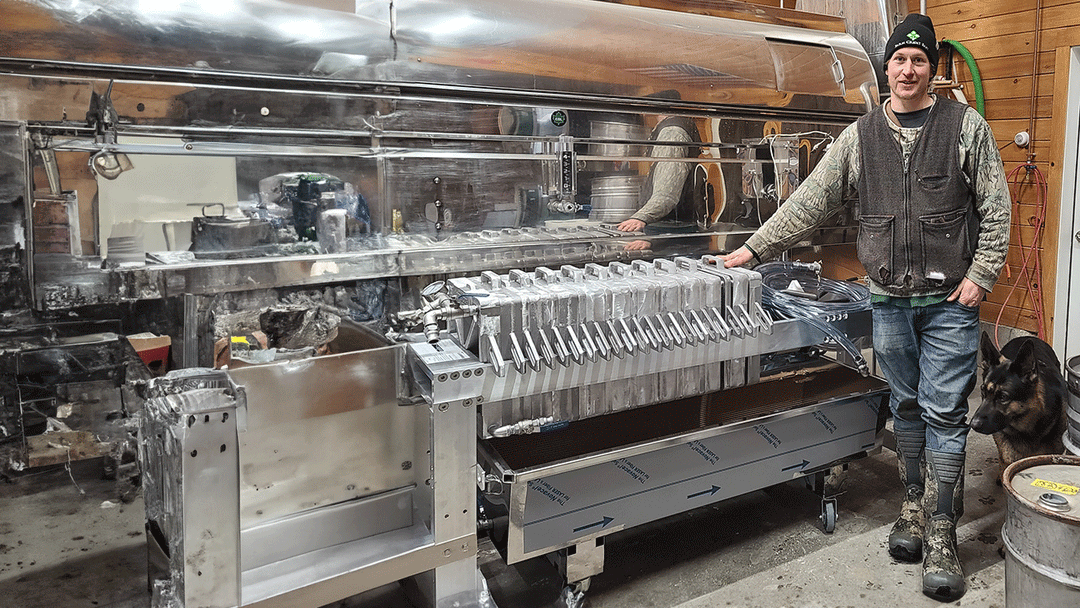Does maple syrup go bad?
Believe it or not, this question is not supported by as much university research as you might think. The first major breakthrough in syrup storage best practices occurred in the 1940’s; however, from that time till now, little has changed. To answer this question properly, your author scoured scholarly sources, as well as the internet itself. While much was learned, no single authority offered a clear answer; so, with the support of known resources, as well as our own decades of hands on, institutional knowledge, I’m going to address the common questions on the matter.
For those who don’t want to stick around for the details, here’s the TLDR (Too Long, Didn’t Read) on best practices for storage and handling to prevent your syrup from spoiling:
Maple syrup will go bad if stored under improper conditions. To prevent spoilage, maple syrup should be stored in a cool, dark location such as a cupboard, refrigerator, or freezer. In this manner, maple syrup can be safely kept for a year or more. Upon opening, store your syrup container in the freezer or refrigerator, consume within a year from the date of opening.

How long does maple syrup last?
Since 1946, when F.W. Hayward published his informative report from Cornell University, sugarmakers have understood that syrup should be packaged hot, and stored under cool conditions. No matter where you procure syrup from, if it isn’t packaged hot (above a 180-degree F), but not too hot (I would recommend less than 195-degrees F), and into a clean container, no number of best practices recommended here will prevent spoilage. Hayward’s original experiment in 1946 only tested samples to seven months, but his findings were interesting, nonetheless.
First, and arguably the most important point, is the effect of storage temperature. In the 1946 experiments, samples were stored at 34F, 70-75F, and 100F. When the final measurements were taken at the end of the seven-month trials, the syrup samples were 1.6 times darker at 100F, 1.2 times at 70-75F, and no detectable darkening at 34F. In 1980, the Agricultural Experiment Station at the University of Vermont built upon these original findings. Their report concluded through statistical analysis that flavor changes were less discernable with darker grades compared to their lighter counterparts. Specifically, 4 of 36 taste panelists noted a difference in taste for Very Dark Strong Taste syrup, compared to 18 of 36 for Amber Rich & Dark Robust Taste syrup. The grading system was much different in 1980 than it is today, so I took the liberty of translating their results in modern terminology. If that didn’t make any sense to you, the testing panel essentially concluded that storage temperatures had a greater effect on light syrup compared to later season, dark syrup.
Less significant, but still identifiable through analysis, were the affects that storage container type has on syrup darkening. The same UVM study from 1980 reported that in descending order, syrup is best stored in glass, plastic, then metal (usually tin). Tin has fallen out of style in the past few decades, for a number of reasons, not the least of which being negative flavor impacts. However, glass and plastic remain popular. Of the two, glass is less permeable to air and darkens significantly less than plastic. Plastic containers and their enclosures have modernized greatly in the 40 years since this study's publication, modern plastics are much less permeable than their early cousins.
Which leads to the real problem, oxidation. Oxidation is not a unique phenomenon to maple syrup, but to most foods in general. A great way to visualize this is to consider apples. When sliced and given a bit of time, apples will increasingly turn brown. The enzymes in the apple react with oxygen, converting the natural phenols into melanin, which is brown in color. Comparatively, this is remarkably similar to maple syrup, albeit at a much, much slower rate. The increased permeability of plastic enables oxygen to penetrate the syrup, this oxygen, combined with higher temperatures, speeds the oxidation process. Which explains why the 1980 UVM study recommends glass as the preferred storage vessel for the maximum extension of maple syrup shelf life. Though, again, the drawbacks of plastic are minimal if you take our recommendations and store your syrup in a cool place. Storing your syrup properly, and controlling for temperature especially, your maple syrup should last up to 2 years.
Does maple syrup need to be refrigerated?

As is evident from the previous section, the simple answer is that yes, you should absolutely refrigerate your syrup, especially after opening. These reasons include everything I have already mentioned; but we’ve yet to address one of the other common ailments you’ll see over time, I’m referring to mold. The single biggest prevention technique for mold growth or spoilage is canning at high temperatures. For the consumer though, proper storage techniques are critical in ensuring maximum shelf life, especially after opening. Store your maple syrup in the refrigerator or freezer if you can!
The first reference of mold appearing in maple syrup occurred in the Botanical Gazette from 1908, F.L. Stevens, the author, doesn’t delve too deep in the weeds, it’s mostly two paragraphs noting that there are, in fact, molds that form on maple syrup. He closes with, “…the concentration of the sugar solution in which the fungus was growing had little effect on the size of the spores or hyphae; and that ammonium nitrate can be used to a limited extent as a source of nitrogen”. Fortunately, ammonium nitrate treatments are not the go to method for mold growth prevention in maple syrup!

My first insights as to the nature of mold in maple syrup were from a few years back, when I read Professor Kathie Hodge’s Mushroom Blog on the subject. The Cornell University professor provides a great fungus 101 about the type of mold that can thrive and grow in the “harsh” environment provided by maple syrup. As I’m sure most of you know, water is evaporated from maple syrup during the production process until a 66% sugar content is achieved. Believe it or not, most molds are unable to thrive in the “desert” environment of maple syrup, except for a certain type, called xerophiles. Professor Hodge explains that the type she encountered, called Wallemia sebi, is the type you would find on dried foods, such as nuts, berries, beef jerky, and the like. Her fact sheet didn’t contain any information on whether the mold, if consumed, posed any dangers to human beings, so the search continued…
To the International Journal of Indoor Environment and Health, also called Indoor Air, which published a helpful piece on the subject. As it turns out, Wallemia sebi is quite common in the dust of your house and doesn’t seem to have a significant allergen causing component. The journals findings indicated that a mixture of allergens, rather than one individually, are likely to cause elevated risk of developing negative respiratory symptoms.
Mold Remedies
So, what does it all mean? Our official recommendation if you find mold in your long-term maple syrup reserve is to remain calm. Remove the mold from the syrup with a spoon, and heat in a pot to 180-195 degrees F for 15 minutes. 15 minutes will be sufficient to neutralize any remaining fungal contamination. I would also recommend that you deposit your remaining syrup into a glass mason jar of some sort, one that you cleaned and sanitized before hand (boiling in water works fine, don’t forget about the covers!). I’ll finish with one additional note, when pasteurizing your syrup, try to avoid reaching a boil, as this will cause minerals suspended in the syrup to precipitate and turn your syrup a bit cloudy (also called niter). This isn’t going to affect the taste, but you may have a bit of sediment cooked to the bottom of your pan. In this case, use white vinegar and hot water to remove.

I took the picture above as I was editing this blog, March 31, 2021 for those wondering. Both bottles were canned during the spring of 2000, 21 years ago with what was called Grade A Medium Amber at the time. As you can see, they've only darkened slightly over the past 20 years, sitting on a shelf in the sugarhouse at whatever room temperature was, season after season. Furthermore, I needed a subject to depict mold and the effects from the passage of time, and these old bottles were the perfect candidate. Thankfully, they delivered and were great exhibits for all of our learning. I'm not sure I'll be opening them up for pancakes in the coming weeks.
References (Those unable to be Hyperlinked within the text)
Desroches, T. C, McMullin, D. R, & Miller, J. D. (2014). Extrolites of Wallemia sebi, a very common fungus in the built environment. Indoor Air, 24(5), 533-542.
Stevens, F. (1908). Mold of Maple Syrup. Botanical Gazette, 46(5), 392-393. Retrieved March 29, 2021, from http://www.jstor.org/stable/2467648
Frasz, S. L., & Miller, J. D. (2015). Fungi in Ontario maple syrup & some factors that determine the presence of mold damage. International Journal of Food Microbiology, 207(0168-1605), 66-70. https://doi.org/10.1016/j.ijfoodmicro.2015.04.038
Hayward, F. W. (1946). The storage of maple sirup (719). Cornell University. https://hdl.handle.net/2027/uiug.30112019762571
Morselli, M. F., & Sendak, P. E. (1980). Maple syrup containers: effect of storage on the stability of three table grades (6). Agricultural Experiment Station, University of Vermont.






Thank you for this great article! It’s exactly the information I was looking for. Also, the article structure was perfect.
In a crazy coincidence your article came up first after I searched “can maple syrup go bad?” and we used to visit your farm and buy your delicious syrup for years while we were guests at the Tyler Place. Thanks for this!
I ordered 150 maple leaf wedding favors on Feb 14th. I received an email immediately informing me that the farm was making my favors. The favors came within a week after I ordered them. They are just beautiful! I loved the personal touch you put into my order! Thank you, Jonathan
Love this! Nathaniel you are a gifted writer…keep this up!😍
Leave a comment